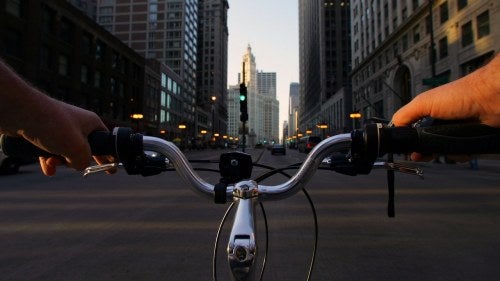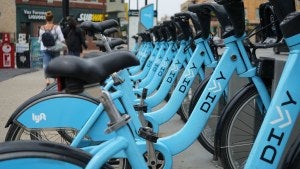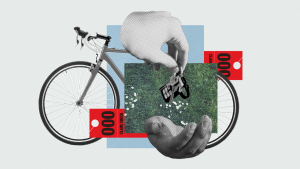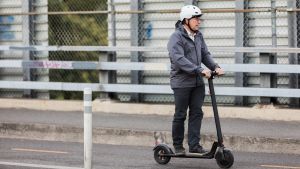Chicago lags behind other global cities for bike-friendliness. Here's how it can improve.

The nonprofit People for Bikes has given Chicago abysmal ratings for bike-friendliness five years in a row. What can the city learn from global cycling hot spots like Paris?
“There is nothing more freeing and simultaneously frightening as riding a bike on Chicago streets.”
That’s Chicagoan Andrew Mack in an op-ed for the Chicago Tribune, writing earlier this month in response to readers being asked about their experiences biking in the city. Mack’s and others’ letters provide a snapshot of people who love riding around town despite the heightened risk of injury or death.
And despite Chicago consistently being named a poor city for cycling.
In June, Colorado-based nonprofit People for Bikes released its annual ranking of global cities by bikeability, and for the fifth year in a row, Chicago found itself near the bottom of the pack — 2,279 out of 2,579 cities worldwide, to be exact.
Anyone who’s ridden down Pulaski Road or Milwaukee Avenue, Chicago’s busiest biking thoroughfare, in the past decade — dodging potholes, double-parked cars, and speeding drivers — knows Chicago isn’t the greatest biking city in the world. But it’s not that bad, right? Surely not worse than sprawling metropolises like Mexico City or Los Angeles, both of which bested Chicago in the rankings.
Chicago’s low score is especially baffling given the city’s recent cycling renaissance.
Last year Chicago built more bicycle infrastructure than any other year in the city’s history, according to the Chicago Department of Transportation. Not only that, trips on the city’s rentable Divvy bikes hit an all-time high of 6.6 million in 2023, up 70% from 2019. And over the past five years, there’s been a 119% increase in biking in Chicago — the greatest among the United States’ 10 largest cities.
That’s not all. Under the Chicago Cycling Strategy, a comprehensive bike-infrastructure plan laid out in March 2023, the city intends to create 150 miles of new bikeways. Eighty-five percent of those will be “low-stress” protected lanes (where there are physical barriers between bike lanes and high-traffic, high-speed streets), neighborhood greenways (low-volume, low-speed side streets where biking is prioritized), or off-street trails.
These are many of the same policies that earn cycle-mad cities like Paris and Amsterdam top marks on global biking surveys. So, why is Chicago’s ranking still in the basement?
That's the greatest increase among the United States' 10 largest cities.
According to People for Bikes, Chicago’s low ranking is largely due to its disconnected network of protected bike lanes — meaning, there are too many unprotected breaks in protected bikeways — and relatively high default speed limit of 30 mph.
Just how significant are these two factors, and what, if anything, is the city doing to improve them?
The need for speed (limits)
In 2022, Rebecca Davies, the People for Bikes City Ratings program director, told Streetsblog Chicago that, if Chicago lowered its default speed limit from 30 to 25 mph, the city would shoot into the top 15 U.S. cities for biking.
The effect of speed limits can already be seen in the list’s British rankings. While the default national speed limit for urban roads in the U.K. is 30 mph, cities and boroughs that have instituted 20 mph limits — including Cambridge, Edinburgh, and London’s Islington — occupy half a dozen spots in People for Bikes’ global top 50.
Streetsblog reporter John Greenfield has argued that weighing the speed limit so heavily skews the reality of biking in Chicago. He concedes, though, that slowing drivers down — in addition to building a better-connected network — would indeed make cycling safer.
Research indicates that a pedestrian’s odds of surviving being hit by a vehicle driving 25 mph are five times better than a person hit at up to 35 mph. The examples of other cities have also borne this out. After New York reduced its default speed limit from 30 mph to 25 mph in 2014, the following nine years saw a 23% decrease in pedestrian deaths.
Chicago’s default limit has remained steadfastly at 30 mph so far, even as the city’s poor People for Bikes rankings piled up — but recent developments at City Hall could soon change that. On July 17, 1st Ward Alderman and biking enthusiast Daniel La Spata introduced measures before the City Council to lower the default speed limit from 30 to 25 mph.
“We know that it works, and it will work here,” he said at a press conference.
The proposed measures follow preliminary discussions in May to lower the limit by the City Council’s Committee on Pedestrian and Traffic Safety, which Ald. La Spata chairs.
If City Council votes in favor of the measure — which Alex Perez of the Active Transportation Alliance told ChicagoGlobal is “looking very likely” — the ordinance would go into effect in early 2026.
Let’s stay together
While lowering the speed limit is a helpful first step, it’s important that the city build infrastructure that further encourages, or even forces, drivers to take their foot off the gas, according to Michael Podgers, policy lead at transit advocacy group Better Streets Chicago. At the Committee on Pedestrian and Traffic Safety meeting in May, Podgers stressed the necessity of not just lowering the default speed limit, but also installing speed humps, raised crosswalks, and protected bike lanes.
It wouldn’t be Chicago if there weren’t a few roadblocks to progress. In this case, one of the barriers is aldermanic privilege. Also known as aldermanic prerogative, aldermanic privilege is the decades-old Chicago tradition wherein alderpeople can veto infrastructure projects in their wards as they see fit.

Divvy bikes parked at a station in Chicago. (Photo: Trevor Grant)

A pedestrian and bike path in downtown Chicago. (Photo: Chris Rycroft)
Rather than City Council being able to pass a citywide ordinance that would create miles of connected (and protected) bike lanes, such projects have traditionally arrived piecemeal in wards with supportive alderpeople and residents. This is why a Chicago cyclist can be enjoying blocks of protected riding, her lane cordoned off from speeding traffic by plastic bollards or concrete barricades, only for that barrier to suddenly disappear because a City Council member does not deem safe cycling a priority for their ward.
And while protected bike lanes may seem like an easy sell, some local business owners are not fans. They say the barriers eliminate parking, resulting in a loss of business. It’s not that parking is eliminated altogether when protected bike lanes are built, said Perez of the Active Transportation Alliance, but that the spaces are moved elsewhere in the area.
And while four decades of research on bike lanes and local commerce show that making streets friendlier for bikes is in general good for businesses — or at least neutral — this doesn’t negate the individual shops that suffer from displaced public parking.
All about the euros
“Focus on, first and foremost, serious funding for bike infrastructure,” Martina Haggerty told ChicagoGlobal when asked what is the most important thing a city can do to improve cycling safety and accessibility.
Haggerty, who is the senior director of local innovation at People for Bikes, added that a lot of the best biking cities in the world became so by “aggressively funding” cycling plans.
A prime example of such aggressive funding is Paris. In 2015, Mayor Anne Hidalgo announced a five-year, €150-million investment in biking infrastructure, which included doubling the total length of biking paths. But she didn’t stop there. In 2020, Hidalgo pledged an additional €250 million over five years for more paths and parking. Paris — which ranks eighth in the world on People for Bikes’ list — is now home to 746 miles of protected bike lanes, and more Parisians bike than drive.
By comparison, Chicago allocated in its 2024 budget over $538.5 million in capital upgrades across the city, including improvements to biking infrastructure and bike sharing. It’s unclear how big of a slice of that half a billion dollars will go to cycling, but it bodes well.
“In terms of the actual infrastructure investments itself, it sounds like [Chicago’s] got it,” Haggerty said.
Despite hurdles like aldermanic privilege and the city’s speeding cars, Chicago’s bike revolution chugs on, even if it’s more slowly than cyclists might want.
“I like to remind folks that Amsterdam was not always what we see today. It wasn’t always an amazing place for people riding bikes … In fact, just a few decades ago, they were just as car-oriented as many North American cities are today,” Haggerty added.
“These things don’t happen overnight.”
This story first appeared in the ChicagoGlobal newsletter, a joint project of Crain's Chicago Business and the Chicago Council on Global Affairs.


Related Content

Midwest biking activists are using a grassroots strategy to highlight the lack of secure bike infrastructure in the region.

Micromobility can play a major role in transportation decarbonization, but its potential varies depending on the conditions in which it's employed.
